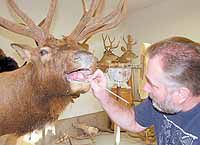| Bill Fox works on the inside of a trophy elk’s mouth |
Bill Fox has always been a hunter and a fisherman, and even though he works full time as a plant operator for Utah Power he supplements his hobby with a business that literally is a clock stopper.
Bobcats are walking off rock ledges and several whitetail deer and trophy elk stare from their positions on the walls as if they could bolt into a grove of aspens at any second. A tiger mushy fish appears ready to set out on a course downstream.
Guests get the feeling they’re being watched the moment they walk into Fox’s workshop located at 300 North in Helper.
The animals at the Fox Taxidermy studio look like they came out of the woods yesterday. Eyes sparkle with vitality. Details are preserved right down to shiny bumps on a deer’s nose and tiny papillose or bumps throughout the insides of a trophy elk’s mouth.
Bill spends a lot of time at conventions and competitions to make sure nature is preserved for decades. He has been trained by the best taxidermists in America. He’s dazzled by what he sees in the outdoors. At one of the studios he was trained in New York he learned the techniques from a world renowned taxidermist who taught open mouth work on white tail deer by using live deer in his classroom.
Bill started studying taxidermy in 1984. He found the premiere artist in the business at that time preserving fresh water fish in Idaho Falls and studyed with him. Then he switched his focus to game mounts and traveled to Iowa, Ohio, New York and Louisiana to learn the best techniques around. Although there are many schools, books and videos showing how to create the art forms, its been the one-on-one training that has aided most to Fox’s professional mounts.
Fox competes in a lot of shows in Utah, Colorado, Idaho, Montana and Wyoming and his wall of ribbons and trophies easily tells the story about his talent and art work.
| Holding two of his winning ribbons, Fox has a wall full of ribbons and awards from various shows throughout the Northwest. |
A trophy elk came to Bill with a closed mouth but the customer wanted it bugling so Bill opened the mouth, created the exact tongue and fretted over hundreds of tiny bumps in the elk mouth.
“I put a lot of little extras into them,” he says in reference to his gallery of mounted animals.
Many of his mounts are trophy pieces shot in Eastern or Southern Utah. Mule deer, white tail deer, elk, antelope, fish, desert big horn sheep, buffalo, and bobcats. He is currently working on a mountain lion and will start on a grizzly bear for the University of Utah later this fall.
“Anybody can learn to put a hide on a form, but the secret to a good mount is in the detail,” explains Bill, as he points out the eyes, ears, hair patterns and nostrils.
“I portray a live animal, not a dead one,” he emphasized, explaining that he purchases all the body parts and then mounts the head, horns, and hide, depending on the customer. If they want a elk bugling I can open their mouth, if they want their trophy elk with a proud, solemn look I can create the mount to portray their beauty and elegant stance.” Once he completed a giant elk (ranked 393 by the numbering system) and currently is working on two elk each with six points.
He has a freezer full of carcases that he will start on today, his first of a 15-day vacation from his “other” job. It will take Fox about eight hours to complete each mount.
So what’s changing in the taxidermy field? The first and most obvious is the number of women hunters. He showed me stacks of pictures with women who have brought in their mountain lions, big horn sheep, bear and elk, all wanting them preserved in unique and specific methods. “Women are often more specific and detail orientated and usually know exactly the type of mount they want their trophy to be. “Everyone is different, and the challenge is meeting the needs of every customer, giving them the mount they want,” he adds.
The other biggest change is the pedestals, the extras, the environment. “We are seeing more elaborate bases and backgrounds,” he explained. Many taxidermists are using reeds, cattails, leaves, and rocks to give the animal a more realistic and natural setting.
The Carbon High graduate attended CEU for a year and is missing the help of his two sons, who are off creating their own lives with jobs, careers and school. He explained that they were a lot of help over the years.
This is his busiest season as most trophy mounts are shot in September and October. Once the hides are sent to the tannery, the body parts ordered and the mount stance decided, Fox goes to work bringing back the dead animals into beautiful still life mounts.
It’s an art and Bill Fox is perfecting it all the time.

